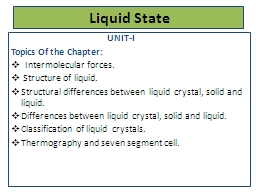

Topics Of the Chapter Intermolecular forces Structure of liquid Structural differences between liquid crystal solid and liquid Differences between liquid crystal solid and liquid Classification of liquid crystals ID: 1017679
Download Presentation The PPT/PDF document "Liquid State ..." is the property of its rightful owner. Permission is granted to download and print the materials on this web site for personal, non-commercial use only, and to display it on your personal computer provided you do not modify the materials and that you retain all copyright notices contained in the materials. By downloading content from our website, you accept the terms of this agreement.
1. Liquid State UNIT-ITopics Of the Chapter: Intermolecular forces. Structure of liquid.Structural differences between liquid crystal, solid and liquid.Differences between liquid crystal, solid and liquid.Classification of liquid crystals.Thermography and seven segment cell.
2. Liquid StateINTERMOLECULAR FORCES: The force of attraction existing among the molecules of a substance (gases, liquid and solid) . Types:1)Dipole-Dipole attraction : This force of attraction occurs among polar molecules which posses permanent dipole moment. for e.g., ammonia, HCl, SO2 etc. have permanent dipole moment.
3. Liquid State Magnitude of dipole-dipole attraction depends upon the dipole moment of the polar molecule.
4. Liquid StateThe average interaction energy between to polar molecules having dipole momentsµ1 and µ2 given by the expression: Where
5. Liquid State2) Dipole-Induced dipole interaction :
6. Liquid StateWhen a permanent dipole (polar molecule) polarizes a non polar molecules which is present near it. For e.g, Force between HCl and H2OThe magnitude of dipole induced dipole is given by the expression.
7. Liquid State 3) Induced dipole-Induced dipole interaction (London forces):
8. Liquid StateThis force of attraction exist between non polar molecules for e.g, H2 or N2 .Due to momentary distortion of electron cloud , a momentary dipole is produced which induces dipoles in neighbouring molecules.
9. Liquid StateSTRUCTURE OF LIQUID: Structure of liquid means arrangement of constituent particle .It is found that the constituent particles of a solid have long range order, those of liquid have short range order where as those of a gas have neither have long range nor short range order. These observations are based uponVolume changes on fusion and vaporization: The volume change is very small on fusion but very large on vaporization.
10. Liquid State2)Enthalpy of fusion and vaporization : Enthalpy of melting of pure solid is very small as compared to enthalpy of vaporization of the liquid.3)X-Ray diffraction studies: Where are a few maxima and minima observed in X –Ray diffraction.
11. Liquid StateStructural Diffrences between Solids, Liquids and GasesS.No.1. 2. SolidTheir X-ray Diffraction pattern have well defined maxima There is short range and long range order. LiquidTheir X –Ray diffraction pattern have 1 or 2 maxima which damp out with distance.There is only short range order. GasesTheir electron diffraction do not have any maxima.There is neither short range nor long range order.
12. Liquid StateS.No3.4.5.SOLIDConstituent particles are closely packed and hence strong intermolecular forces.Solids have high densityParticles have vibrational motion no rotational or translational motionLIQUIDThe molecules are separated by small distances and hence weak inter molecular forces then solid.Have small Density then liquidMolecules have some vibrational , rotational and translational motion.GASESThe molecules are separated by large distances and hence molecular forces are very weak.Lowest densityMolecule have large vibrational , rotational translational motion.
13. Liquid CrystalLiquid Crystals: A large number of organic compounds with long chain molecule on heating melt to give milky liquid(turbid) which on further heating become clear at a definite temperature . On cooling the reverse changes take place exactly at same temperature. The milky liquid(turbid) thus obtained are found to be anisotropic like crystalline solids. These milky liquid are called Liquid crystals or Anisotropic liquid or Para Crystals or Mesomorphic state.
14. Liquid CrystalTYPES OF LIQUID CRYSTALS:Nematic Liquid crystal : There molecules have long axis parallel to each other but they are not arranged in layers .
15. Liquid Crystal2) Smectic Liquid CRYSTAL : There molecules not only have long axis parallel to each other but there are also arranged in layers.
16. Liquid Crystal.3) Cholesteric Liquid Crtystal : There molecules are arranged as in Nematic crystals but the orientation of the axis shift in a regular way in going from one layer to next by giving a helical structure.
17. Liquid CrystalDifference between Liquid Crystal ,Solid and Liquid:When a crystal ion solid is heated generally the following changes takes palace Crystalline solid Smectic Nematic Liquid In the crystalline liquid all the molecule have same orientation and have a regular arrangement in different plane. In Smectic Liquid crystal all the molecules have same orientation and they are in equispaced planes but the arrangement with in the plane is irregular . t1oC t2oC t3oC
18. Liquid Crystal In Nematic Liquid crystals all the molecules have same orientation but they are not equispaced planes. In Liquid all these order are lost .Prepared By B.K
19. Liquid CrystalTHERMOGRAPHY: Due to helical structure of cholesteric liquid crystal, they reflect different colour at different temperature. Using these crystals the temperature variation of skin can be recorded . This technique is called Thermograph. It is used in detection and diagnoses of tumour or breast cancer. The basic principle is that heat changes produced in the effected skin are different from healthy skin.Prepared By B.K
20. Liquid CrystalLiquid Crystal Display and Seven Segment Cell: Light weight display devices such as watches , calculated etc. use liquid crystal for this purpose. A thin film of liquid crystal is placed between two sheets of glass. One of which is coated on one side with an electrically conducted material. When no current is passing the molecules are uniformly oriented and light can pass through cell. When current is applied the molecular alignment changes and the cell appear opaque or black. In LCD watches calculator etc. there are several seven segments section each of which can display one number. Prepared By B.K